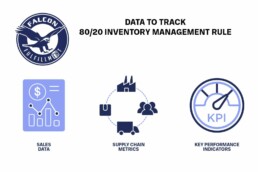80/20 Inventory Management Rule
Determining how to prioritize inventory for maximum profits can take some trial and error. However, a mathematical theory has been successfully applied to multiple industries. It is known as the 80/20 rule. The rule suggests that 80% of results come from 20% of causes. In the case of inventory, it typically shows that 80% of profits come from 20% of products sold. Therefore, the primary purpose of implementing the 80/20 inventory management rule is to maximize profits. Let’s understand what it is, its advantages and drawbacks, and how to implement it.
80/20 Rule Definition and History
Italian economist Vilfredo Pareto first discovered the Pareto Principle in the early 1900s. He observed that 80% of the land was owned by 20% of the population. The principle states that 80% of effects are derived from 20% of causes. Pareto originally applied the principle in the area of economics. The nature of the 80/20 rule is a power distribution law that can be used in many circumstances. It’s super cool, consistent, and profit-boosting math. The rule demonstrates that 80% of sales come from 20% of clients.
Advantages of using the 80/20 inventory management rule
When the principle is effectively applied to inventory management, it can help maximize profitability and increase inventory efficiency. You’ll increase sales when you accurately identify top performers and emphasize them over slower sellers. If you further sort to favor higher-margin products within that 20%, you optimize your inventory for both volume and profitability.
Drawbacks of the 80/20 inventory management rule
The main drawback of using the 80/20 inventory management rule is that it can obscure up-and-coming products that haven’t YET broken into the top 20% category. This is why it is essential to evaluate items against trend reports. Reviewing the products gaining traction will help keep future best sellers in the system long enough to prove their value.

Steps to implement the 80/20 inventory management rule
Integrate and utilize an inventory management system
A system of tracking inventory and sales is required to generate accurate reports of top sellers. The more high-tech your system, the more detail you can generate. Small business owners can run manual inventory reports so long as it is consistent in the type and timeframe. As SKUs and sales increase, implementing an automated inventory management system becomes crucial to success. Here are 7 types of inventory reports that can help implement the 80/20 inventory management rule.
- Inventory performance report – includes sales performance hierarchy as well as year-over-year growth.
- Inventory profitability report – includes SKU profitability, listing profitability, and trending profitability.
- Inventory value report – a quick snapshot of the value of goods stored in your warehouse; this report’s modifications can determine product performance, sitting age, and inventory turnover ratios.
- Stock level report – includes critical levels to determine reordering patterns and prevent stockouts.
- Inventory forecasting report – includes estimates of future sales based on historical data within a set timeframe.
- Sales report – includes a holistic approach to revenue generated from each sales channel, customer, and product vertical.
- Cost of goods sold (COGS) report – helps determine the bottom line on each product, necessary to identify the most profitable products.
Identify 20% of top sellers
To determine the top sellers in your inventory, firstly you must decide what to track and which reports will give you the most accurate picture. At a minimum, it is necessary to consider the following data points:

ABC is a popular method to categorize inventory. Simply put, it is a way to prioritize product performance into three distinct buckets. Using the ABC method helps determine your top sellers’ popularity and profitability.
- A items: Top 20% of your products that result in 70% of sales
- B items: Middle 30% of your products that result in 20% of sales
- C items: Bottom 50% of your products that result in 10% of sales
Refine mid-level performers
Once you discover your top performers, some products will be in the mid-level range. Specifically these are your “B category products” and can include your trending products. This information highlights an opportunity to explore how to make them profitable and change marketing efforts. If modifications don’t move them forward, then it might be time to sunset.
Sunset slow or underperforming products
Once you have tiered your inventory according to profitability and performance, it is time to sunset or liquidate deadstock. Products that are taking up valuable storage space and are slow-moving despite efforts to modify marketing or sales efforts should be liquidated to free up capital for more profitable products. Letting go of slow-moving or deadstock can be difficult, but keeping a healthy bottom line is essential.
Beginner’s Guide to Third-Party Logistics (3PL)
The world of e-commerce is always changing, therefore understanding the roll of Third-Party Logistics is integral to keeping up. In light of this our beginner’s guide to third-party logistics (3PL) will delve into the essential aspects, offering insights into fulfillment services, warehousing, and much more.
Read More…
Retail and e-commerce business owners implementing data-driven methodologies like the 80/20 inventory management rule stand a better chance of success. Their decisions are not based on gut instinct, reacting to customer demand, or marketing trends but on statistical analysis, and the numbers don’t lie. If you want to learn more about how Falcon Fulfillment can help boost profitability and implement the 80/20 rule, get in touch with one of our specialists today.





